FIRST (Far-Infrared Spectroscopy of the Troposphere)
Airborne Sensors
FIRST (Far-Infrared Spectroscopy of the Troposphere)
The FIRST project of NASA/LaRC was selected by NASA in 2002 and funded within the IIP (Instrument Incubator Program). The goal is to develop and demonstrate a Michelson interferometer capable of sensing the spectral region between 10-100 µm (1000 to 100 cm-1) at 0.625 cm-1 resolution (unapodized) and to advance the technology in three specific areas: the interferometer itself; broad bandpass beamsplitters; and FIR (Far Infrared) sensitive detectors. 1) 2) 3) 4) 5) 6)
The objective of the FIRST program is to fill the FIR gap in the existing instruments that monitor the Earth's climate. FIRST provides technology demonstrations in a space-like environment of the key technologies required for a future spaceborne FIR spectral sensor from a balloon platform at high altitudes (35 km).
The partners in the FIRST project are: NASA/LaRC; Space Dynamics Laboratory of Utah State University (SDL/USU), Logan, UT; Smithsonian Astrophysical Observatory (SAO) of Harvard University, Cambridge, MA; NASA/ESTO, NASA/JPL; TAFTS (UK) and REFIR (Italy) Far-IR Teams; and the AERI Team at the University of Wisconsin, Madison.
Note: TAFTS (Tropospheric Airborne Fourier Transform Spectrometer) was built by ICSTM (Imperial College of Science Technology & Medicine), London, and is flown on the UKMO C-130 aircraft. REFIR (Radiation Explorer in the Far Infrared) was an ESA funded concept study by various institutes in Italy.
The science justification with regard to the outgoing radiation budget (Figure 1) lists the following items:
• Up to 50% of the OLR (Outgoing Longwave Radiation), surface and atmosphere, is below 650 cm-1
• Up to 75% of atmospheric OLR is beyond 650 cm-1
• Up to 50% of basic greenhouse effect is in FIR (Far Infrared)
• Clear-sky cooling of free troposphere occurs in FIR
• Upper tropospheric H2O radiative feedback occurs in FIR
• Cirrus and LW cloud radiative forcing has major component in FIR
The radiative balance of the troposphere, and hence climate, is dominated by the infrared absorption and emission of water vapor, particularly at the FIR wavelengths longer than 15 µm. Half of the Earth’s outgoing long-wave radiation occurs beyond 15.4 µm (650 cm-1). Determining the distribution of water vapor and its FIR radiative forcings and feedbacks in this range will possibly resolve uncertainties in understanding and predicting future climate and aid in understanding the greenhouse effect.
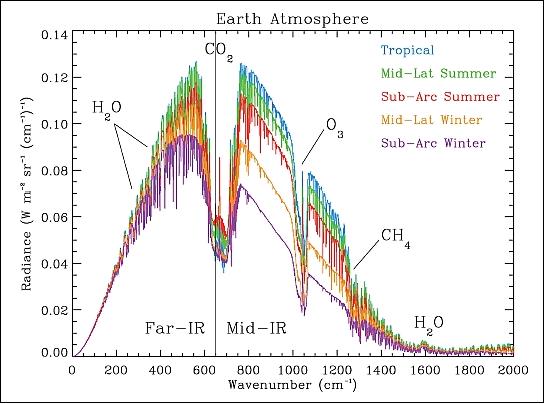
Sensor Complement
The FIRST instrument is a high throughput (0.47 cm2 sr) interferometer covering the 6-100 µm spectral range in a single focal plane with a single broad bandpass beamsplitter is designed to achieve this goal, assuming a 900 km orbit, a ± 45º cross-track scanning mode, and the capability to record 100 interferograms on a 10 x 10 array every 1.2 seconds (i.e., 10 km pixels).
FIRST is an IFTS (Imaging Fourier Transform Spectrometer) measuring the infrared spectrum in the nadir view. In its IIP implementation, only ten of the potential 100 detector elements are populated, with dual detector elements located at each FPA (Focal Plane Assembly) corner and at the FPA center. The detector FPA assembly is LHe cooled to 4 K.
Radiometric calibration of the ten simultaneously collected, 0.6 cm-1 unapodized resolution, Earth view spectra over the full 10 to 100 µm spectral range is provided by sequentially scanning a warm (~ 300 K) deep cavity blackbody and deep space. This calibration system uses the same approach as the HIS (High-resolution Interferometer Sounder), AERI (Atmospheric Emitted Radiance Interferometer), MAERI (Marine Atmospheric Emitted Radiance Interferometer), S-HIS (Scanning High-resolution Interferometer Sounder), NAST (NPOESS Aircraft Sounder Testbed) and CrIS (Cross-track Infrared Sounder), all airborne instruments of NASA. FIRST meets the NEΔT performance goal of 0.2 K from 10 to 60 µm and 0.5 K from 60 – 100 µm.
SDL/USU designed and developed the IFTS portion of the instrument while SAO developed the pellicle beamsplitter film - a film capable of transmission and reflection over the extremely wide passband of the FIRST sensor. LaRC provided the innovative focal plane array, which was based on Winston cone flux concentrator technology, and the focal plane’s helium dewar. 7) 8)
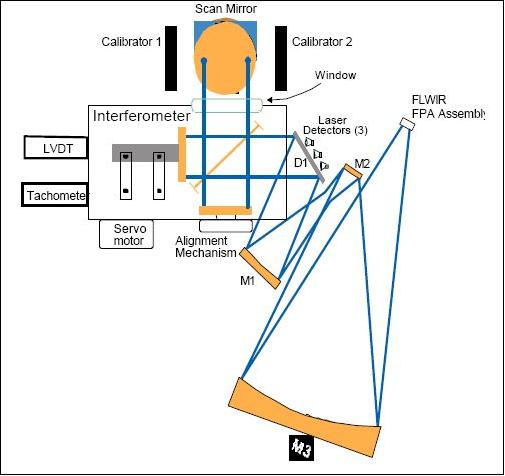
The design approach of the IFTS has been made possible as a result of recent advances in bi-layer beamsplitters, pyroelectric detectors, and high-throughput imaging FTS designs. Detecting the climate change fingerprint requires a spectral noise equivalent change in temperature (NEΔT) of 0.2 K. This requires a signal to noise ratio (SNR) of 350, 545, and 656 at 500 cm-1 (20 µm), 278 cm-1 (36 µm), and 200 cm-1 (50 µm), respectively.
The maximum throughput for a given instrument volume is achieved with a 2-port Michelson design. By using plane mirrors rather than retroreflectors the optical path inside the spectrometer is minimized, reducing the effect of beam divergence and further increasing the throughput.
Winston cones are used to achieve an f/0.5 beam. The f-number is given by 1/(2 sin θ), where θ is half the divergence angle, so that an f/0.5 beam accepts light from ±90º and thus fills one hemisphere of the detector FOV.
The best pyroelectric detectors available have a maximum detectivity of 109 cm Hz1/2 W-1 at 1 kHz. To achieve a band-averaged SNR of 500 (to meet the SNR requirement of 545 at 36 µm) a detector area of 0.012 cm2 is needed behind the Winston cone. Filling the beams of a 10 x 10 array of Winston cones that are matched to this detector requires an instrument throughput of 3.71 cm2 sr, which would be difficult to achieve. For a detector that achieves the thermal noise limit of 1.8 x 1010 cm Hz1/2 W-1 at 300 K, the required detector area is 3.5 x 10-5 cm2 (66 µm pixels) and the spectrometer throughput is reduced to 0.011 cm2 sr, which is comfortably within the range of existing designs. - For comparison, the detectivity of a photon noise limited detector would be ~1011 cm Hz1/2 W-1 for a 230 K scene temperature.
IFTS subsystem: The interferometer uses the 45º beamsplitter design that has been flown successfully on several missions and is being used on GIFTS (Geostationary Imaging Fourier Transform Spectrometer) - a development of LaRC and SDL/USU. The SDL design of IFTS provides a full ± 0.8 cm drive range with mirror alignment accuracy better than ± 2 µrad and repeatability better than 0.2 µrad. Metrology is provided by a laser based quadrature sampling control system that counts fringes through the carriage turnaround. While the space flight system would use a stabilized diode laser, a HeNe laser is being used in FIRST. A frequency stability better than 1 part in 5 x 106, is required.
The laser is mounted in the electronics (warm) section of FIRST, with the output of the laser coupled to the interferometer metrology system via fiber optics. Errors that arise from scan velocity variations are minimized by a precision scan drive, and an optical path difference (OPD) velocity servo system to control the scan speed to better than ±1%. The nominal beam diameter and divergence angle are 7.0 cm and 0.1 rad, respectively, giving a spectrometer throughput of 0.475 cm2 sr. The design is optimized for accurate radiometric imaging.
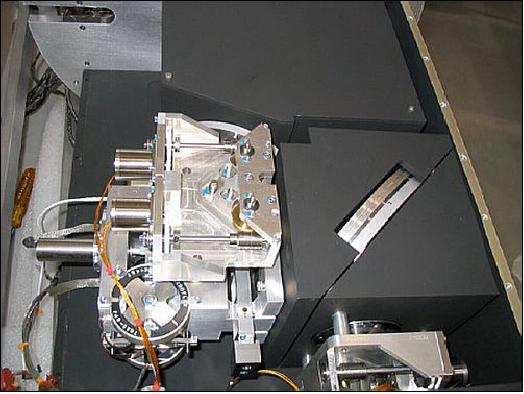
Aft optics and detector array mounting: FIRST uses the compact all-reflective aft optical system developed for GIFTS, scaled to FIRST aperture size and f/#. A diagram of this configuration system is shown in Figure 2. The optics uses gold-coated aluminum for low cost and high reflectivity in the far infrared. The optic system is f/4.4 and allows the interferometer to handle a 6º beam divergence. The FIRST optical aperture (on the interferometer mirrors) is sized to match the FPA assembly (the 10 x 10 array of Winston cones which couple the detectors to the optical beam). To reduce cost, the 10 x 10 array is only partially filled.
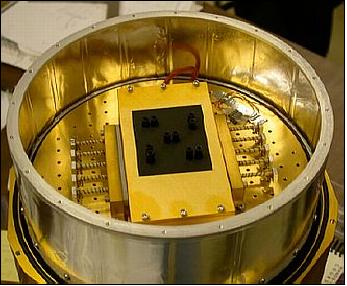
Beamsplitters: The new development of wideband beamsplitters that work well in the far infrared now make it possible to use a single FTS to cover the 10-100 µm band. These include lithographic polarizing (for Martin-Puplett interferometers) and bi-layer beamsplitters (for conventional Michelson interferometers), both of which have demonstrated nearly ideal performance over the required band.
The beamsplitters were developed at SAO as part of its ongoing programs of FIRS-2 instrument development and high-resolution stratospheric measurements. These beamsplitters are constructed of 2 thin dielectric layers, with thickness chosen to give nearly equal 50% transmission and reflection coefficients over a very wide wavelength range in the far and near infrared. The spectral range covered by these beamsplitters includes the entire range required by the FIRST design.
Calibration: FIRST calibration consists of two parts: pre-flight characterization and calibration, and field calibration. FIRST was built and tested in a modular fashion, allowing subsystem performance to be verified before the sensor was fully integrated. Test and calibration procedures and initial performance model predictions were validated using the extensive calibration procedures. The IFTS calibration techniques required for FIRST have been demonstrated using the SDL Imaging Interferometer Demonstrator.
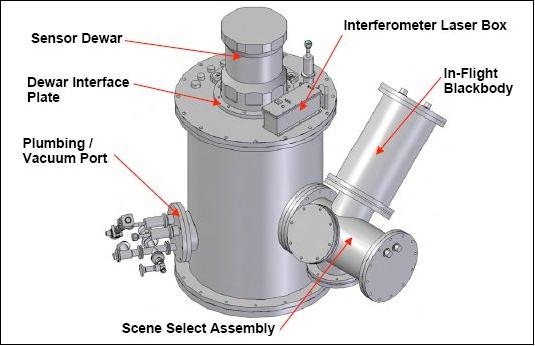
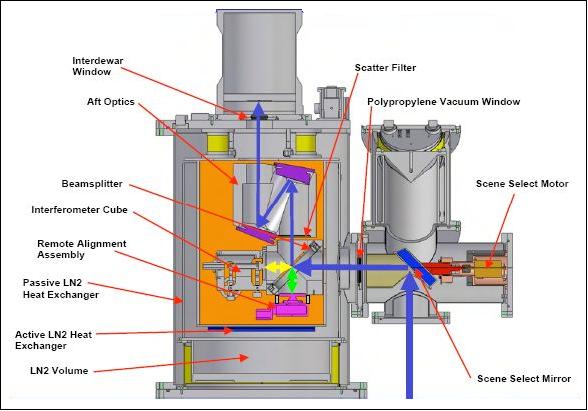
FIRST Instrument Summary
• The FIRST instrument was developed in the time frame 2002-2005 within the IIP (Instrument Incubator Program) of NASA. The completion was within schedule and on budget.
• Average systematic errors are less than 0.001 W/m2 sr cm-1 from 150 to 800 cm-1
• Nearly the complete spectral coverage of the outgoing longwave radiation was obtained (beamsplitter and window absorption result in some small gaps in coverage)
• Data available as HDF5 files - 15 groups worldwide
• The comparison with space and ground standards (AIRS, AERI) is excellent
• FIRST has demonstrated technology to make routine FIR measurements from space - essentially entire thermal IR
• FIRST nominal performance:
- Systematic errors: ~0.7 K @ 600 cm-1
- Precision: 0.1 K rms.
The FIRST instrument is regarded the first imager capable of observing atmospheric emissions in essentially the entire FIR spectrum (10-100 µm).
Flight Campaigns of the FIRST Instrument
• On June 7, 2005, the FIRST sensor was launched on a huge, high altitude helium-filled balloon with a volume of 3.11 x 105 m3. From an altitude of 35 km, the balloon flight demonstrated the new sensor's ability to observe FIR radiation emitted by the Earth's atmosphere. The launch site was Fort Sumner, NM. The flight lasted for more than 5 hours after which the payload was recovered. 9) 10)
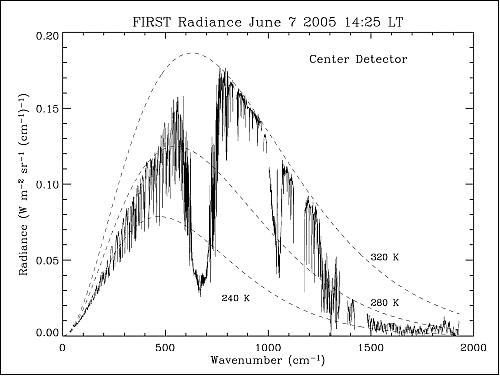
• A second balloon flight for the validation of the FIRST instrument took place on Sept. 18, 2006. The launch site was again Fort Sumner, NM. At the end of the flight, the balloon and the payload landed near the town of Adrian in north Texas. In both flight tests the balloon-borne observations were accompanied by ground-based observations. 11)
This flight was in support of validation activities associated with the “A-Train” series of satellites. The instrument operated nominally again for 6 hours at “float” altitude near 30 km. Figure 8 illustrates a comparison of the far-infrared spectra recorded in 2005 (blue curve) and in 2006 (red curve). There was substantially less emission recorded in 2006 and this has been traced to a lower and middle troposphere that was 15 to 20 degrees cooler in 2006.
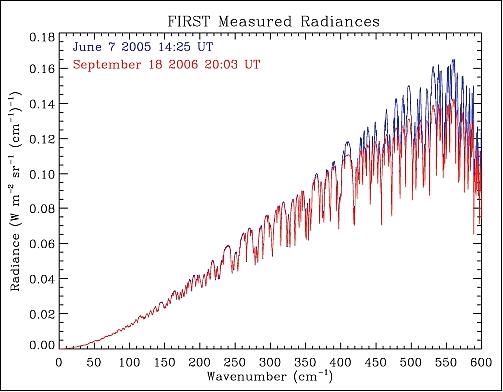
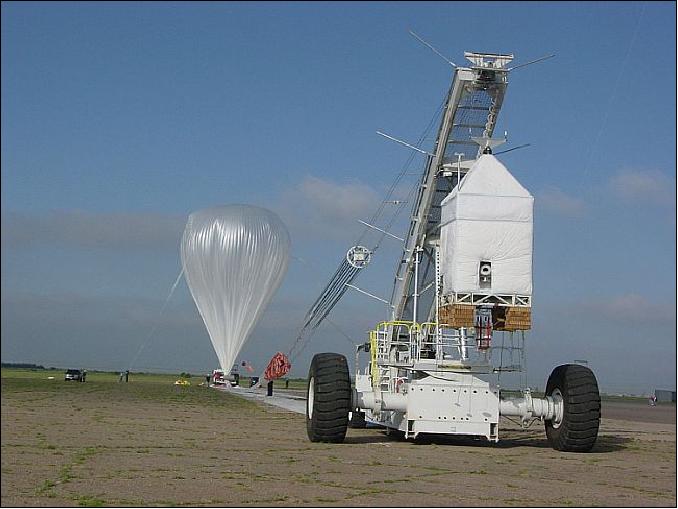
Legend to Figure 9: The FIRST instrument is shown in the foreground hanging to the launch-support vehicle.
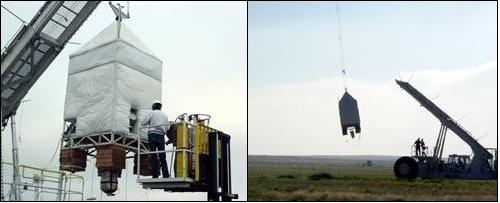
• The FIRST instrument has now transitioned from an “incubator” and “technology demonstration unit” to a full-fledged science instrument. Over the course of 2007 and 2008, a second blackbody was built and the scene select assembly was rotated so that the instrument could view the zenith direction and thus operate from the ground. The second blackbody operates at a different temperature from the first, offering the standard 2-point calibration for the FTS. The instrument may operate in a nadir view mode from a balloon platform or in the zenith view mode from the ground.
• The modifications to enable ground operation of FIRST was to allow participation in field experiments conducted by the Department of Energy Atmospheric System Research (ASR) program. Specifically, from July to November 2009, FIRST participated in the RHUBC-II (Radiative Heating in the Underexplored Bands Campaign – II). The campaign was conducted on the top of Cerro Toco, a mountain 5,300 m above sea level in the Atacama Desert of Chile. FIRST was operated at this altitude along with 3 other FTS instruments to record the entire downwelling infrared spectrum of Earth’s atmosphere from the sub-millimeter to the near-infrared at high spectral resolution.
The purpose of RHUBC-II was to conduct a radiative closure experiment, in which measurements of infrared emission spectra would be compared with calculated spectra. The inputs for the calculations are provided from radiosonde data taken simultaneously with the infrared spectral measurements. The location (and altitude) of the experiment were chosen so as to be above most of the water vapor and thus avail the spectral development of the far-infrared to be observed down as low as 200 wavenumbers.
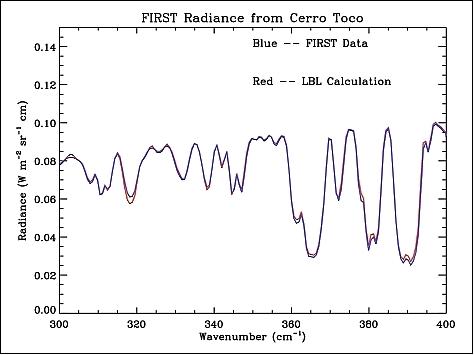
Shown in Figure 11 is a spectrum between 25 and 33 µm (400 to 300 wavenumber) recorded on 5 September 2009 at Cerro Toco. The figure shows the measured FIRST spectrum in blue and the computed spectrum in red. The agreement is quite good at this preliminary stage of the analysis of the data.
In summary, the FIRST project has demonstrated technologies in FTS instruments, optical beamsplitters, and focal planes.
References
1) Martin G. Mlynczak, David G. Johnson, Junilla I. Applin, “The Far-Infrared Spectroscopy of the Troposphere (FIRST) Project,” Proceedings of ISPRS (International Committee on Remote Sensing of Environment) Conference, Honolulu, HI, USA, Nov. 10-14, 2003, URL: http://esto.nasa.gov/conferences/estc-2002/Papers/B4P2(Mlynczak).pdf
2) M. G. Mlynczak, J. E. Harries, R. Rizzi, “The Far-Infrared: A frontier in the remote sensing of Earth’s climate and energy balance,” SPIE, Vol. 4485, 2002, pp. 220-224
3) G. Bingham, H. Latvakoski, S. Wellard, D. Garlick, M. Mlynczak, D. Johnson, W. Traub, K. Jucks, “Far-infrared spectroscopy of the troposphere (FIRST): sensor calibration performance,” URL: http://www.isprs.org/publications/related/ISRSE/html/papers/772.pdf
4) Martin G. Mlynczak, David G. Johnson, M. Nurul Abedin, Maryn Stapelbroek, Henry Hogue, John Reekstin, “The Far-Infrared Detector Technology Advancement Partnership - FIDTAP,” ESTO2006 (Earth Science Technology Office) Conference, College Park, MD, June 27-29, 2006, URL: http://esto.nasa.gov/conferences/estc2006/papers/b5p2.pdf
5) M. Mlynczak, D. Johnson and the FIRST Team,, “The Far-Infrared Spectroscopy of the Troposphere Project – “FIRST”,” CLARREO Workshop, College Park, MD, July 17-19, 2007, URL: http://map.nasa.gov/documents/CLARREO/7_07_presentations/FIRSTmlynczakCLARREO.pdf
6) M. Mlynczak, D. Johnson, “Far-Infrared Spectroscopy of the Troposphere - FIRST,” CERES Science Meeting, May 7, 2008, URL: http://science.larc.nasa.gov/ceres/STM/2008-05/pdf/19_MartyCERESmay2008.pdf
7) “FIRST: Far-Infrared Spectroscopy of the Troposphere,” SDL/USU, URL: http://www.sdl.usu.edu/programs/first
8) M. G. Mlynczak, D. G. Johnson, J. I. Applin, “The Far-Infrared Spectroscopy of the Troposphere (FIRST) Project,” NASA Earth Science Technology Conference 2002, Pasadena, CA, June 11-13, 2003; URL: http://esto.gsfc.nasa.gov/conferences/estc-2002/Papers/B4P2(Mlynczak).pdf
9) http://www.nasa.gov/centers/langley/science/FIRST.html
10) D. R. Feldman, K. N. Liou, Y. L. Yung, D. G. Johnson, M. L. Mlynczak, “Determination of atmospheric temperature, water vapor, and heating rates from mid- and far- infrared hyperspectral measurements,” AGU Fall Meeting, Wednesday, December 12, 2007, URL: http://www.gps.caltech.edu/~drf/misc/agu2007/agufm_2007.ppt
11) Martin Mlynczak, David Johnson, Richard Cageao, M. Nurul Abedin, David Kratz, “From Incubator to Space: Ten Years of Infrared Sensor Technology Development at NASA Langley,” Proceedings of the ESTF 2010 (Earth Science Technology Forum), Arlington, VA, USA, June 22-24, 2010, URL: http://esto.nasa.gov/conferences/estf2010/papers/Mlynczak_Martin_ESTF2010.pdf
The information compiled and edited in this article was provided by Herbert J. Kramer from his documentation of: "Observation of the Earth and Its Environment: Survey of Missions and Sensors" (Springer Verlag) as well as many other sources after the publication of the 4th edition in 2002. Comments and corrections to this article are always welcome for further updates (eoportal@symbios.space).